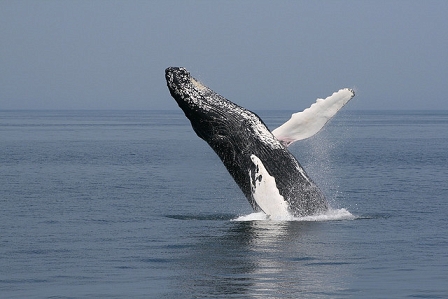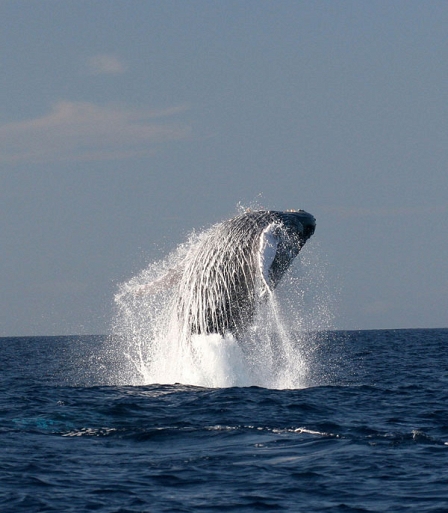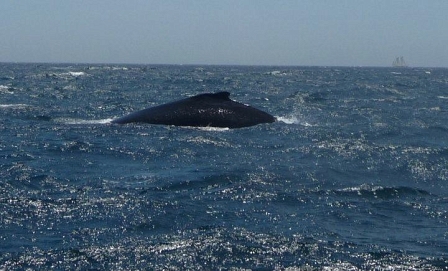Erstellt am: 7. 12. 2011 - 13:22 Uhr
Meeting Moby Dick
The humpback whale burst out of the dark ocean about 20 metres from the speed boat. It seemed unendingly large and water was streaming down its flanks. It must have weighed all of 30 tons but for an instant it seemed to hang in the air before hitting the sea surface again, not elegantly like a diver but falling backwards and onto its side and disappearing in a huge splash. The last thing I saw of the whale it disappeared under the foaming water was one knobby-edged giant flipper. It looked as if it was waving good bye.

paulcjones
“F*ck me! He`s big” I said excitedly to my Australian guide Tim.
Tim’s reaction to my outburst was impenetrable behind his wrap-around sunglasses but nonetheless I looked at the ground in great shame. I am sure Sir David Attenborough has never been shocked into obscenity like that - it didn’t seem very professional. But seeing a whale jump – or breach, to use the technical term - was once of the most incredible things I had ever seen. “The muscles of the fully-grown hump-back whales’ tale are the strongest muscles in the world.” Tim explained “Two swipes of the tail and they can be completely out of the water.” It was a truly awe-inspiring sight.
It was a windy day and we were in a small boat just outside Sydney Harbour – the high cliffs of Manly were shimmering yellow in the sun. The whales were on their seasonal migration down from the southern part of Great Barrier Reef to the rich feeding waters of the Antarctic summer. While waiting out the last few weeks for the water to warm up near the ice cap, they were hanging out just off the east coast of New South Wales, unhurriedly turning circles not far from land.
Two pods, each consisting of a mother and her calf, had met up and now the calves were playing. They were breaching ever closer to the boat with Tim and I their delighted audience. Every now and then we saw the dark back of a mother come between the boat and her calf warning, I suppose, each of us not to get too close.

NOAA's National Ocean Service
This was a big moment for me. I had always wanted to see whales, those great symbols of freedom, in the wild. But I had worried that it was wrong to pursue these amazing animals on boats. I didn’t want to intrude. But Tim insisted that they welcomes out presence: “They don’t mind us being here at all. In fact, humpback whales are very curious of the boat. Sometimes they will come right up to the boat stick their head out of the water and have a look at you.” This is called, apparently, “mugging”. Moby-Dick author Herman Melville called humpbacks "the most gamesome and light-hearted of all the whales" and they were playing to form.
My conscience had already been soothed beforehand by the words of Philip Hoare who, in 2009, wrote a wonderful and prize-winning book about whales called Leviathan. Whale-watching, he says, is “vivid reminder of how quickly we have moved from seeing whales as a resource to be consumed to a natural wonder to be conserved.”
Dieses Element ist nicht mehr verfügbar
That is not entirely true, unfortunately – there are still plenty of Captain Ahab`s in the Japanese whaling fleet that has vowed to renew its hunt of whales in the Antarctic in the coming months where they will do battle with the anti-whaling fleet of Sea Shepherd. Yesterday the Japanese whaling factory ship Nisshin Maru has left in Innoshima, southern Japan today in what conservationists fear is the departure of the whaling fleet for the Antarctic. Greenpeace alleges that this year the whaling expedition is being paid for by international relief money donated in the wake of this spring`s tsunami and nuclear disaster.
Australia has been one of the most vocal opponents of Japan’s policy. This year Prime Minister Julia Gillard’s Labour government refused to drop International Court of Justice challenge to the Japanese hunt. Jonathon Larkin of the WWF Australia thinks that is partly due to the relationship built up between whales and the Australian public. He sees the hump-backs off Sydney as ambassadors for conservation: “It makes us understand that there is a deep connection there to the environment and that we need to do things to keep that in balance as much as possible,” he says.

christian cummins
The more people who go out and see a whale migration, thinks Larkin, the more people will do what they can to reduce their environmental impact: “Once you see a creature like that in the wild, it changes your perspective instantly. It makes you understand that there is a deep connection there to the environment.”
In Sydney you don’t have to go far to see a whale. You can spy them from the cliff tops that separate the iconic beaches of Bondi and Coogee and a couple of years ago a pair of humpback whales just outside Sydney Opera House. “I don’t know anywhere else in the world where you have this sort of interaction,” says Larkin. “It’s pretty unique.”


